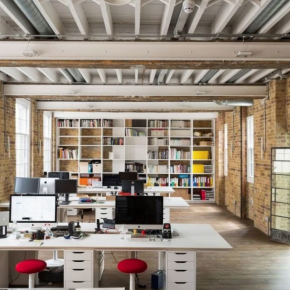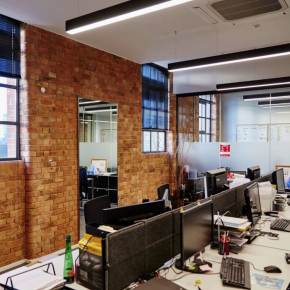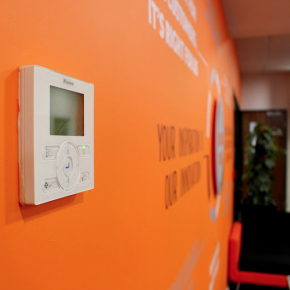
GUEST ARTICLE: Thermal Comfort in the Workplace
This guest article from 361 Degrees looks at WELL Buildings and how air quality can affect a workplace.
“When the poet John Lydgate wrote ‘you can please some of the people all of the time, you can please all of the people some of the time, but you can’t please all of the people all of the time’ he probably wasn’t referring to workplace temperature control.
However, there may be no better way of describing the challenge of maintaining a perfect environment in modern buildings.
The way that each person experiences thermal conditions is different, and there’s no simple explanation of ‘too hot’ or ‘too cold’.
So, when taking a holistic approach to building design, the aim is to consider all of the factors that affect thermal comfort in the workplace, and to ensure that the majority of people experience comfort for a majority of the time.
With colder winters to endure, buildings in the UK are designed to retain warmth. Mainly built from brick, our buildings store heat and slowly release it over a period of time, but with our summers getting warmer, they’re becoming increasingly unreliable at keeping us comfortable, both during and after a heatwave.
A recent study discovered that office productivity drops by 4% when environments are too cold, and by 6% when the office is too hot.
But the effects could go even further, potentially leading to health risks. Looking beyond Sick Building Syndrome, people may start to avoid certain areas of the office that are too cold (potentially to the detriment of their work) or may not wear appropriate personal protective equipment (PPE) if they’re too hot.
When looking at thermal comfort, the Health and Safety Executive outlines six basic factors, and it’s the combination of these factors that affect a person’s perception of their comfort.
- Air temperature: The most common measurement of air temperature surrounding the body. However, alone it does not give us enough information to indicate how comfortable a space is.
- Radiant temperature: With a greater effect on the body, radiant heat sources cause you to feel warmer than a thermometer measuring the air temperature will show us. Think about how the sun heats you up on a winter’s day. The air temperature doesn’t change, but the direct impact of radiant heat on your body can prompt you to remove your coat. The effect is the same indoors, when radiant heat sources cause you to feel warmer than a thermometer measuring air temperature will show.
- Air velocity: We’ve all experienced draughts, and understand how distracting they can be. Cooling your office space to the perfect temperature using blasts of cold air can be disconcerting.
- Humidity: High humidity levels can stump the body’s ability to cool down naturally by sweating, while low humidity contributes to a spread of viruses that can cause irritation.
- Clothing insulation: While environmental factors are more commonly known, workplace policies such as company uniforms or PPE requirements can limit our ability to adapt our wardrobes to the changing environments.
- Metabolic heat: Affected by physical attributes such as age, size and level of fitness, the amount of heat produced by our bodies from physical work should also be taken into account.
The WELL Building approach to making the majority of people comfortable for the majority of the time is to use these parameters to create a model for predicting whether people will be satisfied.
Once these satisfactory conditions are established, they need to be met for 98% of the building’s occupied hours of the year.
That means the designers of a WELL Building need to prove that the sort of weather extremes the building wouldn’t cope with, are expected for no more than 2% of the year.
A more advanced standard included in the WELL criteria assesses humidity control, while looking at the ability of individuals to adjust their own environment.
The control of air speed, air temperature and radiant temperature can drastically improve comfort levels, therefore including policies such as a flexible dress code can have a significant effect on granting more control over personal preferences.
The key to achieving optimal thermal comfort is having the right equipment in the right place, and for the right purpose – so ensuring you have an experienced designer is vital.
By looking at building design with a holistic approach, we can get much closer than ever to pleasing everyone, all of the time.
Latest news

26th July 2024
Enfield Speciality Doors completes world-class project for Atlas Copco HQ
A rundown office and warehouse building completely transformed into a modern headquarters for Atlas Copco has been fitted with more than 120 internal fire doors from Enfield Speciality Doors.
Posted in Access Control & Door Entry Systems, Articles, Building Industry News, Building Products & Structures, Building Systems, Case Studies, Doors, Interior Design & Construction, Interiors, Posts, Restoration & Refurbishment, Retrofit & Renovation, Security and Fire Protection, Sustainability & Energy Efficiency, Timber Buildings and Timber Products, Wooden products
26th July 2024
Abloy UK launches new white paper
Abloy UK, a leading provider of security and access control solutions, has launched a new white paper.
Posted in Access Control & Door Entry Systems, Architectural Ironmongery, Articles, Building Industry News, Building Products & Structures, Building Services, Doors, Facility Management & Building Services, Health & Safety, Information Technology, Innovations & New Products, Publications, Research & Materials Testing, Security and Fire Protection
26th July 2024
MCRMA Member Profile: David Roy, Director of Roofconsult
David Roy of MCRMA member company Roofconsult has more than 50 years’ experience to draw upon working in the building envelope sector and a unique perspective on how it has changed in that time.
Posted in Articles, BIM, Infrastructure & CAD Software, Building Associations & Institutes, Building Industry News, Building Products & Structures, Building Services, Building Systems, Cladding, Information Technology, Restoration & Refurbishment, Retrofit & Renovation, Roofs, Walls
26th July 2024
Strand: Enhancing Door Functionality and Safety
Craig Fox, Sales Director for Strand Hardware, outlines how door industry professionals might apply door limiting stays…
Posted in Architectural Ironmongery, Articles, Building Industry News, Building Products & Structures, Building Services, Doors, Facility Management & Building Services, Health & Safety, Restoration & Refurbishment, Retrofit & Renovation
 Sign up:
Sign up: 
